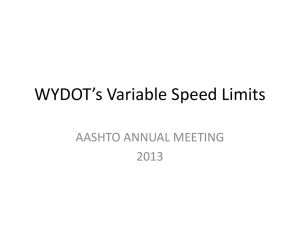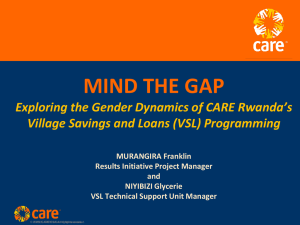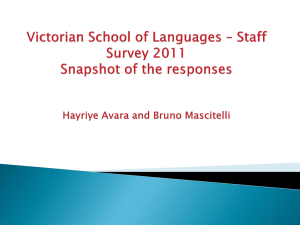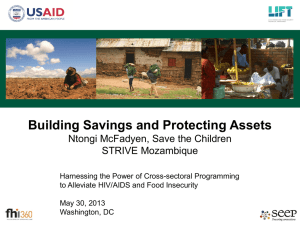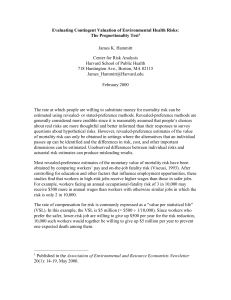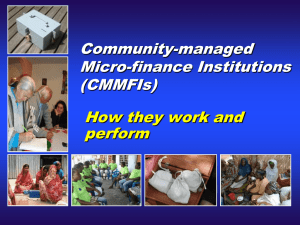An Empirical Bayes Approach to Combining Estimates of the Value
advertisement
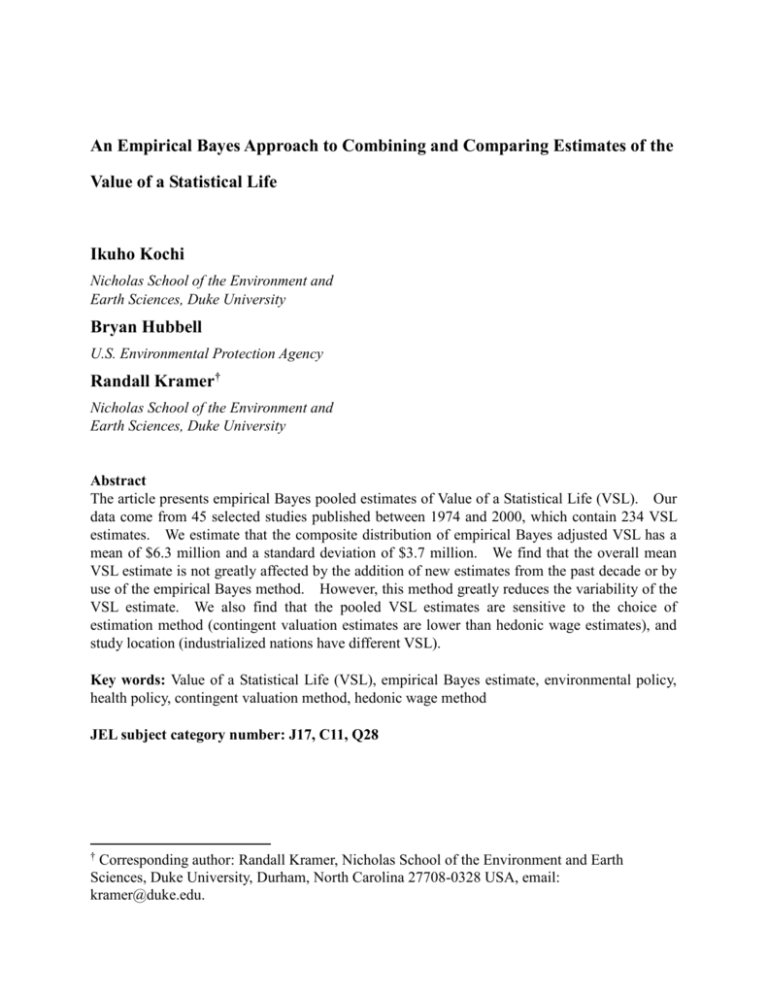
An Empirical Bayes Approach to Combining and Comparing Estimates of the Value of a Statistical Life Ikuho Kochi Nicholas School of the Environment and Earth Sciences, Duke University Bryan Hubbell U.S. Environmental Protection Agency Randall Kramer† Nicholas School of the Environment and Earth Sciences, Duke University Abstract The article presents empirical Bayes pooled estimates of Value of a Statistical Life (VSL). Our data come from 45 selected studies published between 1974 and 2000, which contain 234 VSL estimates. We estimate that the composite distribution of empirical Bayes adjusted VSL has a mean of $6.3 million and a standard deviation of $3.7 million. We find that the overall mean VSL estimate is not greatly affected by the addition of new estimates from the past decade or by use of the empirical Bayes method. However, this method greatly reduces the variability of the VSL estimate. We also find that the pooled VSL estimates are sensitive to the choice of estimation method (contingent valuation estimates are lower than hedonic wage estimates), and study location (industrialized nations have different VSL). Key words: Value of a Statistical Life (VSL), empirical Bayes estimate, environmental policy, health policy, contingent valuation method, hedonic wage method JEL subject category number: J17, C11, Q28 † Corresponding author: Randall Kramer, Nicholas School of the Environment and Earth Sciences, Duke University, Durham, North Carolina 27708-0328 USA, email: kramer@duke.edu. The value of a statistical life is one of the most controversial and important components of any analysis of the benefits of reducing environmental health risks. Health benefits of air pollution regulations are dominated by the value of premature mortality benefits. In recent analyses of air pollution regulations (U.S. EPA, 2000), benefits of reduced mortality risks accounted for well over 90 percent of total monetized benefits. The absolute size of mortality benefits is driven by two factors, the relatively strong concentration-response function, which leads to a large number of premature deaths predicted to be avoided per microgram of ambient air pollution reduced, and the value of a statistical life, estimated to be about $6.3 millioni. In addition to the contribution of VSL to the magnitude of benefits, the uncertainty surrounding the mean VSL estimate accounts for much of the measured uncertainty around total benefits. Thus, it is important to obtain reliable estimates of both the mean and distribution of VSL. EPA uses the value of a statistical life (VSL) to estimate the benefits of reducing premature mortality from exposure to pollution. The VSL is the measurement of the sum of society’s willingness to pay (WTP) for one unit of fatal risk reduction. Rather than the value for any particular individual’s life, the VSL represents what a whole group is willing to pay for reducing each member’s risk by a small amount (Fisher et al. 1989). For example, if each of 100,000 persons is willing to pay $10 for the reduction in risk from 2 deaths per 100,000 people to 1 death per 100,000 people, the VSL is $1 million ($10 100,000). Since fatal risk is not directly traded in markets, non-market valuation methods are applied to determine WTP for fatal risk reduction. The two most common methods for obtaining estimates of VSL are the revealed preference approach including hedonic wage and hedonic price analyses, and the stated preference approach including contingent valuation, contingent ranking, and conjoint methods. EPA does not conduct original surveys but relies on existing VSL studies to determine the appropriate VSL to use in its cost-benefit analyses. The primary source for VSL estimates used by EPA in recent analyses has been a study by Viscusi (1992). Based on the VSL estimates recommended in this study, EPA fit a Weibull distribution to the estimates to derive a mean VSL of $6.3 million, with a standard deviation of $4.2 million. We extend Viscusi’s study by surveying recent literature to account for new VSL studies published between 1992 and 2001. This is potentially important because the more recent studies show a much wider variation in VSL than the studies recommended by Viscusi (1992). The estimates of VSL reported by Viscusi range from 0.8 to 17.7 million. More recent estimates of VSL range from as low as $0.1 million per life saved (Hammitt and Graham, 1999), to as high as $87.6 million (Arabsheibani and Marin, 2000). Careful assessment is needed to determine the plausible range of VSL, taking into account these new findings. There are several potential methods that can be used to obtain estimates of the mean and distribution of VSL. In a study prepared under section 812 of the Clean Air Act Amendments of 1990 (henceforth called the EPA 812 report), it was assumed that each study should receive equal weight, although the reported mean VSL in each study differs in its precision. For example, Hammitt and Graham (1999) estimate a VSL of $12.8 million with standard error of $0.6 million, while Leigh (1987) reports almost the same VSL ($12.3 million) but with a much larger standard error ($6.1 million). As Marin and Psacharopoulos (1982) suggested, more weight should be given to VSL estimates that have smaller standard errors. 2 Our analysis takes a different approach by estimating the mean and distribution of VSL using the empirical Bayes estimation method in a two-stage pooling model. The first stage groups individual VSL estimates into homogeneous subsets. The second stage uses an empirical Bayes model to incorporate heterogeneity among samples. This approach allows the overall mean and distribution of VSL to reflect the underlying variability of the individual VSL estimates, as well as the observed variability between VSL estimates from different studies. Our overall findings suggest the mean VSL is relatively robust and the empirical Bayes method reduces the variability of the estimates. In addition, we conduct sensitivity analyses to examine how mean VSL is affected by estimation method, study location, and the addition of estimates with missing information on standard errors. 1. Methodology 1.1 Study selection We obtained published and unpublished VSL studies by examining previously published meta-analysis or review articles, citations from VSL studies and by using web searches and personal contacts. The data were prepared as follows. First, we selected qualified studies based on a set of selection criteria applied in Viscusi (1992). Second, we recorded all possible VSL estimates and associated standard errors in each study. Third, we made subsets of homogeneous VSL estimates and calculated the representative VSL for each subset by using the fixed effects approach. Each step is discussed in detail below. Since the empirical Bayes estimation method (pooled estimate model) does not control for the overall quality of the underlying studies, careful examination of the studies is required for selection purposes. In order to facilitate comparisons with the EPA 812 report, we applied the same selection criteria that were applied in that report. Viscusi (1992) examined 37 hedonic wage (HW), hedonic price (HP) and contingent valuation (CV) studies of the value of a statistical life, and listed four criteria for determining the value of life for policy applications. The first criterion is the choice of VSL estimation method. Viscusi (1992) found that all the HP studies evaluated failed to provide an unbiased estimate of the dollar side of the risk-dollar tradeoff, and tend to underestimate VSL. Therefore only HW studies and CV studies are included in this study. The second criterion is the choice of the risk data source for HW studies. Viscusi argues that actuarial data reflect risks other than those on the job, which would not be compensated through the wage mechanism, and tend to bias VSL downward. Therefore some of the initial HW studies that used actuarial data are removed from this analysis. The third criterion is the model specification in HW studies. Most studies apply a simple regression of wage rates on risk levels. However, a few of the studies estimate the tradeoff for discounted expected life years lost rather than simply risk of death. This estimation procedure is quite complicated, and the VSL estimates tend to be less robust than in a simple regression estimation approach. Only studies using the simple regression approach are used in this analysis. The fourth criterion is the sample size for CV studies. Viscusi argues that the two studies he considered whose sample sizes were 30 and 36 respectively were less reliable and should not be used. In this study, a threshold of 100 observations was used as a minimum sample sizeii. 3 There are several other selection criteria that are implicit in the 1992 Viscusi analysis.iii The first is based on sample characteristics. In the case of HW studies, he only considered studies that examined the wage-risk tradeoff among general or blue-collar workers. Some recent studies only consider samples from extremely dangerous jobs, such as police officer. Workers in these jobs may have different risk preferences and face risks much higher than those evaluated in typical environmental policy contexts. As such, we exclude those studies to prevent likely downward bias in VSL relative to the general population. In the case of CV studies, Viscusi only considered studies that used a general population sample. Therefore we also exclude CV studies that use a specific subpopulation or convenience sample, such as college students. The second implicit criterion is based on the location of the study. Viscusi (1992) considered only studies conducted in high income countries such as U.S., U.K. and Japan. Although there is an increasing number of CV or HW studies in developing countries such as Taiwan, Korea and India, we exclude them from our analysis due to differences between these countries and the U.S. Miller (2000) found that income level has a significant impact on VSL, and because we are seeking a VSL applicable to U.S. policy analysis, inclusion of VSL estimates from low income countries may bias VSL downward. In addition, there are potentially significant differences in labor markets, health care systems, life expectancy, and preferences for risk reductions between developed and developing countries. Thus, our analysis only includes studies in high-income OECD member countries.iv. 1.2 Data preparation In VSL studies, authors usually report the results of a hedonic wage regression analysis, or WTP estimates derived from a CV survey. A few authors report all of the VSL that could be estimated based on their analysis, but most authors reported only selected VSL estimates and provided recommended VSL estimates based on their professional judgment. This judgment subjectively takes into account the quality of analysis, such as statistical significance of the result, or the target policy to be evaluated. Changes in statistical methods and best practices for study design during the period covered by our analysis may invalidate the subjective judgments used by authors to recommend a specific VSL. To minimize potential judgment biases, as well as make use of all available information, we re-estimate all possible VSLs based on the information provided in each study and included them in our analysis as long as they met the basic criteria laid out by Viscusi (1992). Estimation of VSL from HW studies Most of the selected HW studies use the following equation to estimate the wage-risk premium: LnYi = a1 pi + a2 qi + Xi β + εi (1) where Yi is equal to earnings of individual i, pi and qi are job related fatal and non-fatal risk faced by i (qi often omitted), Xi is a vector of other relevant individual and job characteristics (plus a constant) and εi is an error term. Based on equation (1), the VSL is estimated as follows. VSL = (dlnY/ dpi) wage unit of fatal riskv 4 (2) VSL is usually evaluated at the mean annual wage of the sample population. The unit of fatal risk is the denominator of the risk statistic, i.e. 1000 if the reported worker’s fatal risk is 0.02 per 1000 workers. If there is an interaction term between fatal risk and human capital variables such as “Fatal Risk” “Union Status”, the VSL is also evaluated at the mean values of the union status variable. Estimation of standard error of VSL from HW studies The standard error of the VSL (SE(VSL)) from a HW study is: SE (VSL) = SE ((dlnY/ dpi)) * mean annual wage * unit of fatal risk (3) If there are interaction terms between the fatal risk and human capital variables, the covariances are required to estimate SE ((dlnY/dpi)). However, no studies report those covariances. Therefore, these variables are assumed to be independent of each other and to have zero covariance. This can lead to an overestimation or underestimation of SE(VSL) depending on the sign of the covariance termvi. Estimation of VSL and standard error from CV studies For most of the CV surveys, we could not estimate the VSL and its standard error unless the author provided mean or median WTP and standard error for a certain amount of risk reduction. The VSL and its standard error are simply calculated as WTP divided by the amount of risk reduction, and SE(WTP) divided by the amount of risk reduction, respectively. Estimation of representative VSL for each study Most studies reported multiple VSL estimates. For the empirical Bayes approach, which we use in our analysis, each estimate is assumed to be an independent sample, taken from a random distribution of the conceivable population of studies. This assumption is difficult to support given the fact that there are often multiple observations from a single study. To solve this problem, we constructed a set of homogeneous (and more likely independent) VSL estimates by employing the following approach. We arrayed individual VSL estimates by study author (to account for the fact that some authors published multiple articles using the same underlying data). We then examined homogeneity among sub-samples of VSL estimates for each author by using Cochran’s Q-statistics. The test statistic Q is the sum of squares of the effect about the mean where the ith square is weighted by the reciprocal of the estimated variance. Under the null hypothesis of homogeneity, Q is approximately a 2 statistic with n -1 degrees of freedom (DerSimonian and Laird, 1986). If the null hypothesis was not rejected, we applied the fixed effects model to estimate the representative mean VSL for that author. The mean VSL and its standard error for a fixed effects model were computed by following equations: 1 Var (VSLi ) 1 Var(VSL ) i VSL i Fixed Effects Adjusted VSL = 5 (4) Fixed Effects Adjusted SE of VSL = ( 1 ) 1 Var (VSLi ) (5) If the hypothesis of homogeneity was rejected, we further divided the samples into subsets according to their different characteristics such as source of risk data and type of population, and tested for homogeneity again. We repeated this process until all subsets were determined to be homogeneous. 1.3 The empirical Bayes estimation model In general, the empirical Bayes estimation technique is a method that adjusts the estimates of study-specific coefficients (β’s) and their standard errors by combining the information from a given study with information from all the other studies to improve each of the study-specific estimates. Under the assumption that the true β’s in the various studies are all drawn from the same distribution of β’s, an estimator of β for a given study that uses information from all study estimates is generally better (has smaller mean squared error) than an estimator that uses information from only the given study (Post et al. 2001). The empirical Bayes model assumes that β i = i ei (6) where βi is the reported VSL estimate from study i, μi is the true VSL, ei is the sampling error and N(0, si2) for all i = 1,…, n. The model also assumes that μi = μ + δi (7) where μ is the mean population VSL estimate, δi captures the between study variability, and N(0, τ2), τ2 represents both the degree to which effects vary across the study and the degree to which individual studies give biased assessments of the effects (Levy et al., 2000; DerSimonian and Laird, 1986). The weighted average of the reported βi is described as μw . The weight is a function of both the sampling error (si2) and the estimate of the variance of the underlying distribution of β’s (τ2). These are expressed as follows; w w * μw = i i (8) * i s.e. (μw) = (∑ wi*) -1/2 (9) 1 where wi* = 1 wi 2 and wi = 1 s i2 τ2 can be estimated as τ2 = max 0, (Q (n 1)) 2 wi wi w i (10) 6 where Q = ∑wi (βi – β*)2 (Cochran’s Q-statistic) and β* = w w i i i The adjusted estimate of the βi is estimated as i Adjusted βi = w 2 ei 1 1 ei 2 (11) This adjustment pulls the estimates of βi towards the pooled estimate. The more within-study variability, the less weight the βi receives relative to the pooled estimate, and the more it gets adjusted towards the pooled estimate. The adjustment also reduces the variance surrounding the βi by incorporating information from all β’s into the estimate of βi. (Post et al. 2001). In our analysis, βi corresponds to the VSL of the ith study. In order to construct a composite distribution of the adjusted VSL, we used kernel density estimation. The kernel estimation provides a smoother distribution than the histogram 1 n x Xi approach. The Kernel estimator is defined by f ( x) . The kernel function, K nh i 1 h K ( x)dx 1, is usually a symmetric probability density function, e.g. the normal density, and h is window width. The kernel function K determines the shape of the bumps, while the window width h determine their width. The kernel estimator is a sum of ‘bumps’ placed at observations and the estimate f is constructed by adding bumps up (Silverman 1986). We assumed a normal distribution for K and a window width h equal to 0.7, which was wide enough to give a reasonably smooth composite distribution while still preserving the features of the distribution (e.g. bumps). The choice of window width is arbitrary, but has no impact on the statistical comparison which is described below. To compare the different distributions of VSL, we applied the bootstrap method, which is a nonparametric method for estimating the distribution of statistics. Bootstrapping is equivalent to random sampling with replacement. The infinite population that consists of the n observed sample values, each with probability 1/n, is used to model the unknown real population (Manly 1997). We conducted re-sampling 1000 times, and compared the distributions in terms of mean, median and interquartile range. 2. Results and sensitivity analyses In total, we collected 48 HW studies and 29 CV studies. After applying the selection criteria outlined in section 2.1, there were 31 HW studies and 14 CV studies left for the analysis (see Appendix available from the authors upon request). In our final list, there are 22 new studies published between 1990 and 2000. We re-estimated all possible VSL for those studies, and obtained 234 VSL estimatesvii. There were 26 VSL estimates for which standard errors were not available, and thus they are excluded from our primary analysis, although we examine the impact of excluding those studies in a sensitivity analysis. After testing for 7 homogeneity among sub-samples, we obtained 59 VSL subsets, and estimated a representative VSL and standard error for each subset. Finally, we applied the empirical Bayes method and obtained an adjusted VSL value for each subset. The unadjusted and empirical Bayes adjusted VSL estimates for the 59 subsets are presented in Table 1. It is worthwhile to note how the empirical Bayes approach reduces the variability among VSL estimates. Our 234 VSL estimates show an extremely wide range from $0.1 million to $87.6 million. The VSL estimates from the 59 subsets range from $0.3 million to $78.8 million and the adjusted VSL estimates range from $0.7 million to $17.1 million. 2.1 The distribution of VSL Figure 1 shows the kernel density estimates of the composite distribution of the empirical Bayes adjusted VSL (using the 59 representative VSL estimates) and for the 26 unadjusted VSL estimates included in the EPA 812 report. The summary results are shown in Table 2. The composite distribution of adjusted VSL has a mean of $6.3 million with a standard error of $3.7 million. Applying the same kernel density approach to the 26 VSL estimates in the EPA 812 report yields a composite distribution with a mean of $6.2 million and a standard error of $4.3 million, which are almost the same moments of the Weibull fitted distribution reported in the Section 812 report. The mean value of the new empirical Bayes derived distribution is almost identical to that of EPA 812 distribution, but has less variance even though our VSL sample has a range five times as wide as the EPA 812 sample. 2.2 2.2.1 Sensitivity analyses Sensitivity to choice of estimation method Many researchers argue that the VSL is sensitive to underlying study characteristics (Viscusi 1992, Carson, et al. 2000, Mrozek and Taylor 1999). One of the most interesting differences is in the choice of valuation method between HW and CV. To determine the difference between the empirical Bayes adjusted distributions of VSL using HW and CV estimates, we used bootstrap tests of significance to test the hypothesis that HW and CV estimates of VSL are from the same underlying distribution. We divided the set of VSL studies into HW and CV and applied the homogeneity subsetting process and empirical Bayes adjustment method to each group. The kernel density estimates of the distributions for HW and CV sample are shown in Figure 2. The HW distribution has a mean value of $8.8 million with a standard error of $5.0 million, while the CV distribution has much smaller mean value of $2.8 million with a standard error of $1.3 million. Bootstrap tests of significance show the VSL based on HW is significantly larger than that of CV (p<0.001), comparing means, medians and interquartile ranges between the distributions. 2.2.2 Sensitivity to study location Because of differences in labor markets, health care systems, and societal attitudes towards risk, VSL estimates from HW studies may potentially be sensitive to the country in which the study was conducted. Empirical Bayes estimation was applied to HW samples from the U.S., U.K. and Canada separately. The kernel density estimated distributions of VSL for the U.K. and U.S. are shown in Figure 3, and those for the U.S. and Canada are shown in Figure 4. The distribution for the U.S. sample has a mean value of $8.3 million with a standard 8 error of $5.0 million, while the distribution for the U.K. sample has a mean value of $15.6 million with a standard error of $7.4 million. Bootstrap tests of significance did not reject the hypothesis that the U.S. estimates are equal to the U.K. estimates, comparing means, medians and interquartile ranges between the distributions. The distribution for the Canadian estimates has a mean value of $4.0 million with a standard error of $0.6 million. Bootstrap tests of significance show that the Canadian VSL estimates are significantly smaller than those from the U.S. (p<0.001) by comparing means, medians and interquartile ranges between distributions. 2.2.3 Sensitivity to excluded VSL estimates We also examine the sensitivity of our estimates to excluded estimates. To do this, we added to the sample the VSL estimates that were excluded from the primary analysis due to the lack of a standard error. We assumed for this test that all reported VSL estimates should have passed at least a 95 percent significance test, and estimate the corresponding standard error for each VSL. This added seven adjusted VSL estimates to the set of 59 representative estimates, including two estimates from HW studies and five from CV studies. The kernel density estimated distributions derived from the new dataset are shown in Figure 5. The distribution of the enhanced sample has a mean value of $5.7 million with a standard error of $3.5 million. Compared with the result of main analysis, the mean value is reduced by $0.6 million. This is because most of estimates that were excluded are derived from CV, which tends to produce relatively lower VSL. Bootstrap tests of significance show the VSL from HW studies is still significantly different from that from CV studies (p<0.0001), comparing means, medians and interquartile ranges. 3. Conclusions Starting from a baseline of the literature used in Viscusi (1992), our analysis has demonstrated that the overall mean VSL estimate from the literature is not greatly impacted by the addition of new estimates from 1992 to 2001 or by the application of the empirical Bayes adjustment approach. However, the variability around that estimate is reduced when the empirical Bayes approach is applied. In our primary analysis, the standard error around the empirical Bayes estimate of the mean VSL is reduced by around $0.6 million, or 14 percent, even though our VSL sample has a much wider range than the EPA 812 sample. This suggests that there is significant within and between study variability present in the VSL estimates. In addition, use of the empirical Bayes approach facilitates comparisons of subsamples of VSL estimates, allowing us to investigate important differences between hedonic wage and contingent valuation studies and the impact of study location. These sensitivity analyses demonstrated that HW studies produce VSL estimates that are significantly higher than those derived from CV studies. However, further efforts are required to generalize this conclusion. Theoretically, the two methodologies should not provide the same results because the HW approach is estimating a local trade-off, while the CV approach approximates a movement along a constant expected utility locus (Viscusi and Evans 1990, Lanoie, Pedro and Latour 1995). However, the impact and direction of this difference have not been thoroughly investigated. Aggregate level comparisons as we have done in this paper are useful in comparing the 9 overall distribution of VSL estimates from each method, however the resulting comparison might be significantly affected by the differences in study design of each study, as the large variance in the HW distribution suggests. This problem could be addressed by applying meta-regression analysis, which can determine the impact of specific study factors by taking into consideration study characteristics such as sample population or study location (Levy et al., 2000; Mrozek and Taylor, 2001). Study location does seem to matter, but additional investigation is necessary to identify location specific factors that cause differences. Simply lumping countries together as developed or developing may not be the best way to account for potential differences in VSL, as evidenced by our finding of differences between the U.S. and Canada, but not between the U.S. and the U.K. Differences in health care systems may be a potential factor, as the U.S. and U.K. systems are closer than the U.S. and Canadian systems, but there may be numerous other socio-cultural factors that can cause VSL estimates to diverge. As the excluded studies sensitivity analysis indicates, our results are sensitive to the addition of small magnitude VSL estimates with low variances. For example, Krupnick (2000) estimated the VSL as $1.1 million with standard error of $1.1 million. If we remove this estimate from our main analysis, the overall mean VSL is increased to $6.6 million, implying that one study reduces the overall mean by $0.3 million. Therefore we should examine the reliability of CV studies very carefully by assessing the questionnaire and scope effects (Hammitt and Graham, 1999). In addition, it may be important to investigate why the VSL estimates from CV studies are so similar despite the differences in type of risk, study location and survey method. In addition to the application of the empirical Bayes method, our analysis also demonstrates the importance of adopting a two-stage procedure for combining evidence from the literature when multiple estimates are available from a single source of data. The first stage sorting process using the Cochran’s Q test for homogeneity seems a reasonable approach to control for over-representation of any one dataset. From the original set of 45 studies we obtained 234 VSL estimates and then classified these into 59 homogeneous subsets. This suggests that there was a high probability of assigning too much weight to some estimates if a single stage process were used, treating each of the 234 estimates as independent. Also, the two-stage approach does not discard information from each study. Instead it uses all the available information in an appropriate manner. As in the epidemiology field, the economics profession should consider developing protocols for combining estimates from different studies for policy purposes. Consistent reporting of both point estimates of VSL and standard errors, or variance-covariance matrices would enhance the ability of future researchers to make use of all information in constructing estimates of VSL for policy analysis. Additional research is needed to understand how VSL varies systematically with underlying study attributes, such as estimation method or location of studies. The empirical Bayes approach outlined here provides a useful starting point in developing the dependent variables for such studies. 10 References: Arabsheibani, R. G., and A. Marin. (2000). “Stability of Estimates of the Compensation for Damage”, Journal of Risk and Uncertainty 20, 247-269. Carson, Richard T., Nicholas E. Flores, and Norman F. Meade. (2000). Contingent Valuation: Controversies and Evidence. Discussion paper 96-36R. San Diego: Department of Economics, University of California. Carthy, Trevor et al. (1999). “On the Contingent Valuation of Safety and the Safety of Contingent Valuation: Part 2-The CV/SG “Chained” Approach”, Journal of Risk and Uncertainty 17, 187-213. Corso, Phaedra S., James K. Hammitt, and John D. Graham. (2001). “Valuing Mortality-Risk Reduction: Using Visual Aids to Improve the Validity of Contingent Valuation”, Journal of Risk and Uncertainty 23(2): 164-183. Cousineau, Jean-Michel, Robert Lacroix and Anne-Marie Girard. (1992). “Occupational Hazard and Wage Compensating Differentials”, Review of Economics and Statistics 74: 166-169. DerSimonian, Rebecca, and Nan Laird. (1986). “Meta-analysis in Clinical Trials”, Controlled Clinical Trials 7, 177-188. Dickens, Williams T. (1984). “Differences Between Risk Premiums in Union and Nonunion Wages and the Case for Occupational Safety Regulation”, The American Economic Review 74, 320-323. Dilingham, Alan E. (1985). “The Influence of Risk Variable Definition on Value of Life Estimates”, Economic Inquiry 24, 277-294. Dorsey, Stuart. (1983). “Employment Hazards and Fringe Benefits: Further Tests for Compensating Differentials”. In John D. Worral. (eds.), Safety and the Work Force: Incentives and Disincentives in Worker’s Compensation. Ithaca: Cornell University, ILR Press. Dorsey, Stuart, and Norman Walzer. (1983). “Workers' Compensation, Job Hazards and Wages”, Industrial and Labor Relations Review 36, 642-654. Fisher, Ann, Lauraine G. Chestnut and Daniel M. Violette. (1989). “The value of Reducing Risks of Death: A Note on New Evidence”, Journal of Policy Analysis and Management 8.1, 88-100 Garen, John. (1988). “Compensating Wage Differentials and the Endogeneity of Job Riskiness”, The Review of Economics and Statistics 70, 9-16. Gegax, Douglas, Shelby Gerking, and William Schulze. (1991). “Perceived Risk and the Marginal Value of Safety”, Review of Economics and Statistics, 589-596. Geirgiou, Stavros. (1992). Valuing Statistical Life and Limb: A Compensating Wage Differentials Evaluation for Industrial Accidents in the UK. Working Paper GEC 92-13. London: Center for Social and Economic Research on the Global Environment (CSERGE). Gerking, Shelby, Menno de Haan, and William Schulze. (1988). “The Marginal Value of Job Safety: a Contingent Valuation Study”, Journal of Risk and Uncertainty 1, 185-199. Gill, Andrew M. (1998). “Cigarette Smoking, Illicit Drug Use and the Value of Life”, Social Science Journal 35, 361-376. Hammitt, James K. and John D. Graham. (1999). “Willingness to Pay for Health Protection: Inadequate Sensitivity to Probability?”, Journal of Risk and Uncertainty 8, 33-62. 11 Herzog, Henry W. Jr., and Alan M. Schlottmann. (1990). “Valuing Risk in the Workplace: Market Price, Willingness to Pay, and the Optimal Provision of Safety”, Review of Economics and Statistics 72, 463-470. Johannesson, Magnus, Per-Olov Johansson, and Richard M. O’Conor. (1996). “The Value of Private Safety Versus the Value of Public Safety”, Journal of Risk and Uncertainty 13, 263-275. Jones-Lee, Michael W. (1989). The Economics of Safety and Physical Risk. Oxford: Blackwell. Krupnick, Alan et al. (2000). Age, Health, and the Willingness to Pay for Mortality Risk Reductions: a Contingent Valuation Survey of Ontario Residents. Washington D.C.: Resources For the Future Discussion Paper 00-37, Resources For the Future. Lanoie, Paul, Carmen Pedro, and Robert Latour. (1995). “The Value of a Statistical Life: A Comparison of Two Approaches”, Journal of Risk and Uncertainty 10: 235-257. Leigh, Paul J. (1987). “Gender, Firm Size, Industry and Estimates of the Value-of-Life”, Journal of Health Economics 6, 255-273. Leigh, Paul J. (1995). “Compensating Wages, Value of a Statistical Life, and Inter-Industry Differentials”, Journal of Environmental Economics and Management 28, 83-97. Leigh, Paul J. and Roger N. Folsom. (1984). “Estimates of the Value of Accident Avoidance at the Job Depend on Concavity of the Equalizing Differences Curve”, The Quarterly Review of Economics and Business 24, 55-56. Levy, Jonathan I., James K. Hammitt, and John D. Spengler. (2000). “Estimating the Mortality Impacts of Particulate Matter: What Can Be Learned from Between-Study Variability?”, Environmental Health Perspectives 108, 108-117. Ludwig, Jens and Philip J. Cook. (1999). The Benefits of Reducing Gun Violence: Evidence from Contingent Valuation Survey Data. Working Paper 7166. Cambridge: National Bureau of Economic Research. Manly, Bryan F.J. (1997). Randomization, Bootstrap and Monte Carlo Methods in Biology (2 nd edition). London: Chapman & Hall. Marin, Alan, and George Psacharopoulos. (1982). “The Reward for Risk in the Labor Market: Evidence from the United Kingdom and Reconciliation with Other Studies”, Journal of Political Economy 90, 827-853. Martinello, Felice and Ronald Meng. (1992). “Workplace Risks and the Value of Hazard Avoidance”, Canadian Journal of Economics 25, 333-345. Meng, Ronald and Douglas Smith. (1990). “The Valuation of Risk of Death in Public Sector Decision-Making”, Canadian Public Policy 16,137-144. Meng, Ronald. (1989). “Compensating Differences in the Canadian Labour Market”, Canadian Journal of Economics 12, 413-424. Miller Ted R. (2000). “Variations Between Countries in Values of Statistical Life”, Journal of Transport Economics and Policy 34.2, 169-188 Miller, Paul, Charles Mulvey, and Keith Norris. (1997). “Compensating Differentials for Risk of Death in Australia”, Economic Record 73, 363-372. Miller, Ted and Jagadish Guria. (1991). The Value of Statistical Life in New Zealand. Wellington: Land Transport Division, New Zealand Ministry of Transport. Moore, Michael J. and Kip W. Viscusi. (1988). “Doubling the Estimated Value of Life: Results Using New Occupational Fatality Data”, Journal of Policy Analysis and Management 7, 12 476-490. Mrozek, Janusz R. and Laura O. Taylor. (1999). What Determines the Value of Life? A Meta-Analysis, Unpublished. Olson, Craig A. (1981). “An Analysis of Wage Differentials Received by Workers on Dangerous Jobs”, Journal of Human Resources 16, 167-185. Post, E. et al. (2001). “An Empirical Bayes Approach to Estimating the Relation of Mortality to Exposure to Particulate Matter”, Risk Analysis 21. (Forthcoming) Scotton, Carol R.and Laura O. Taylor. (2000). “New Evidence from the Labor Markets on the Value of a Statistical Life”, Working Paper. Atlanta: Department of Economics, Andrew Young School of Policy Studies, Georgia State University. Siebert, S.W. and X Wei. (1994). “Compensating Wage Differentials at Workplace Accidents: Evidence for Union and Nonunion Workers in the UK”, Journal of Risk and Uncertainty 9, 61-76. Silverman, Bernard W. (1986). Density Estimation for Statistics and Data Analysis, London: Chapman and Hall. Smith, Robert S. (1974). “The Feasibility of an 'Injury Tax' Approach to Occupational Safety”, Law and Contemporary Problems 38, 730-744. Smith, Robert S. (1976). The Occupational Safety and Health Act: Its Goals and Achievements. Washington: American Enterprise Institute. United States Environmental Protection Agency (USEPA). (1997). The Benefits and Cost of the Clean Air Act, 1970 to 1990. Washington: USEPA. USEPA (1999). The Benefits and Cost of the Clean Air Act, 1990 to 2010. Washington: USEPA. Viscusi, Kip W. (1978). “Labor Market Valuations of Life and Limb: Empirical Evidence and Policy Implications”, Public Policy 26, 359-386. Viscusi, Kip W. (1979). “Compensating Earnings Differentials for Job Hazards”. In Viscusi, W. Kip (eds.), Employment Hazards: an Investigation of Market Performance. Cambridge: Harvard University Press. Viscusi, Kip W. (1980). “Union, Labor Market Structure, and the Welfare Implications of the Quality of Work”, Journal of Labor Research 1, 175-192. Viscusi, Kip W. (1981). “Occupational Safety and Health Regulation: Its Impact and Policy Alternatives”, Research in Public Policy Analysis and Management 2, 281-299. Viscusi, Kip W. (1992) Fatal Tradeoffs: Public and Private Responsibilities for Risk, New York: Oxford University Press. Viscusi, Kip W. and William N. Evans. (1990). “Utility Functions That Depend on Health Status: Estimates and Economic Implications”, American Economic Review 80, 353-374. Viscusi, Kip W., Wesley A. Magat, and Joel Huber. (1991). “Pricing Environmental Health Risks: Survey Assessments of Risk-Risk and Risk-Dollar Trade-Offs for Chronic Bronchitis”, Journal of Environmental Economics and Management 21, 32-51. 13 Table 1. Unadjusted and Empirical Bayes Adjusted VSL Estimates Type of study # of estimates Unadjusted VSL* (million $ in 2000) Adjusted VSL Dickens (1984) (1) HW 1 21.4 16.1 Dickens (1984) (2) HW 1 11.9 8.6 Dickens (1984) (3) HW 1 7.5 7.1 Dickens (1984) (4) HW 2 5.1 5.7 Dillingham (1985) (1) HW 2 0.6 0.9 Dillingham (1985) (2) HW 2 5.9 6.1 Dillingham (1985) (3) HW 1 9.1 7.2 Dillingham (1985) (4) HW 1 0.3 4.7 Dillingham (1985) (5) HW 2 2.4 3.6 Dillingham (1985) (6) HW 2 4.8 5.2 Dillingham (1985): New York HW 8 1.1 1.2 Dorsey (1983), Dorsey and Walzer (1994) HW 3 13.1 8.4 Garen (1988) HW 1 7.1 6.6 Gegax et al. (1991) HW 14 2.5 2.8 Gill (1998) (1) HW 1 4.7 5.3 Gill (1998) (2) HW 3 8.4 7.7 Gill (1998) (3) HW 3 0.8 3.3 Herzog and Schlottman (1990) HW 1 12.1 10.6 Leigh (1987), Leigh and Folson (1984) HW 14 9.4 8.9 Leigh (1995) (1) HW 1 8.1 7.3 Leigh (1995) (2) HW 1 16.7 11.4 Author (year) 14 Leigh (1995) (3) HW 1 12.8 7.0 Leigh (1995) (4) HW 1 11.1 8.5 Moore & Viscusi (1988) HW 8 6.3 6.3 Olson (1981) HW 8 11.2 9.3 R.S. Smith (1974) HW 2 12.8 9.8 R.S. Smith (1976) HW 3 8.3 7.6 Scotton and Taylor (2000) HW 1 19.7 17.8 Viscusi (1978, 1979, 1980) HW 28 6.6 6.6 Visucusi(1981) HW 4 11.0 9.7 Arabsheibani & Marin (2000) (1) HW 2 29.6 10.0 Arabsheibani & Marin (2000) (2) HW 1 18.2 8.2 Arabsheibani & Marin (2000) (3) HW 2 78.8 7.1 Geogeou (1992) HW 1 16.8 7.3 Marin & Psacharopulos (1982) HW 7 5.7 5.7 Siebert & Wei (1994) HW 12 7.7 7.4 Martinello & Meng (1992) HW 13 3.4 3.5 Causineau et al. (1992) HW 3 4.8 4.8 Meng & Smith (1990), Meng (1989) HW 10 3.7 4.3 Miller (1997) (1) HW 2 17.5 15.5 Miller (1997) (2) HW 1 10.5 9.2 Corso et al. (2001) CV 8 3.4 3.4 Gerking et al. (1988) CV 1 4.3 4.8 Hammitt and Graham (1999) (1) CV 1 1.9 1.9 Hammitt and Graham (1999) (2) CV 1 1.1 1.1 15 Hammitt and Graham (1999) (3) CV 1 0.7 0.7 Hammitt and Graham (1999) (4) CV 2 7.2 6.9 Hammitt and Graham (1999) (5) CV 2 2.5 2.5 Ludwig and Cook (1999) CV 2 6.1 6.2 Viscusi et al. (1991) CV 1 12.4 9.0 Cathy et al. (1999) (1) CV 4 1.8 1.8 Cathy et al. (1999) (2) CV 4 3.0 3.0 Jones-Lee (1989) CV 1 7.0 6.7 Johannesson et al. (1996) (1) CV 2 6.0 6.0 Johannesson et al. (1996) (2) CV 1 3.4 3.5 Johannesson et al. (1996) (3) CV 1 1.9 2.0 Miller and Gunia (1991) CV 1 1.6 1.6 Krupnick (2000) (1) CV 1 1.1 1.1 Krupnick (2000) (2) CV 1 3.3 3.4 * Value after applying fixed effects model to homogeneous subsets. 16 Table 2. Results of Empirical Bayes Estimates and Bootstrap Test for Distribution Comparison Mean SD Bootstrap Test (million $) (million $) Mean Median Interquatile Distribution comparison by study method Total 6.3 3.7 P-value (Ho: HW = CV) CV 2.8 1.3 <0.001 <0.001 <0.001 HW 8.8 5.0 Distribution comparison by study location USA 8.3 5.0 P-value (Ho: US =UK/Canada) UK 15.6 7.4 0.807 0.805 0.680 Canada 4.0 0.6 <0.001 <0.001 <0.001 Distribution comparison by study method after adding excluded estimates Total 5.7 3.5 P-value (Ho: HW = CV) CV 2.6 1.3 <0.001 <0.001 <0.001 HW 8.6 4.9 17 density(v1adj, width = 7000000, from = 0, to = 30000000, na.rm = T)$y Figure 1. Comparison of Kernel Distribution of Empirical Bayes Adjusted VSL with Distribution of VSL Based on EPA Section 812 Report Estimates 10^-7 0.00000004 0.00000000 EPA 812 sample 0 0.00000002 New sample 2*10^-8 0.00000006 6*10^-8 0.00000008 4*10^-8 0.0000001 8*10^-8 Probability 0 0.0 5*10^6 5.0 10^7 10.0 1.5*10^7 2*10^7 2.5*10^7 15.0 20.0 25.0 density(v1adj, width = 7000000, from = 0, to = 30000000, na.rm = T)$x V VSL (million US 2000$) 18 3*10^7 30.0 density(v2adj, width = 7000000, from = 0, to = 30000000, na.rm = T)$y Figure 2. Comparison of Kernel Distribution of Empirical Bayes Adjusted VSL Based on HW and CV Estimates 0.00000005 0.00000000 10^-7 5*10^-8 0.00000010 CV HW 0 0.00000015 1.5*10^-7 Probability 00.0 5*10^6 5.0 10^7 10.0 1.5*10^7 15.0 2*10^7 20.0 2.5*10^7 25.0 density(v2adj, width = 7000000, from = 0, to = 30000000, na.rm = T)$x VSL (million US 2000$) 19 3*10^7 30.0 density(v1adj, width = 7000000, from = 0, to = 30000000, na.rm = T)$y Figure 3. Comparison of Kernel Distribution of VSL Based on HW in U.S. and U.K. 8*10^-8 Probability 0.00000008 6*10^-8 U.S. 0.00000006 4*10^-8 U.K. 2*10^-8 0.00000004 0 0.00000002 0.00000000 0 0.0 5*10^6 5.0 10^7 10.0 1.5*10^7 15.0 2*10^7 20.0 2.5*10^7 25.0 density(v1adj, width = 7000000, from = 0, to = 30000000, na.rm = T)$x VSL (million US 2000$) 20 3*10^7 30.0 Figure 4. Comparison of Kernel Distribution of VSL Based on HW in U.S. and Canada 1.5*10^-7 0.00000010 0.00000005 Canada U.S. 5*10^-8 0.00000015 10^-7 0.00000020 2*10^-7 density(v2adj, width = 7000000, from = 0, to = 30000000, na.rm = T)$y Probability 0 0.00000000 0 0.0 5*10^6 5.0 10^7 10.0 1.5*10^7 15.0 2*10^7 20.0 2.5*10^7 25.0 density(v2adj, width = 7000000, from = 0, to = 30000000, na.rm = T)$x VSL (million US 2000$) 21 3*10^7 30.0 density(v2adj, width = 7000000, from = 0, to = 30000000, na.rm = T)$y Figure 5. Comparison of Kernel Distribution of Empirical Bayes Adjusted VSL Based on HW and CV Estimates with Additional Estimates Probability 0.00000005 1.5*10^-7 Total 10^-7 0.0000001 5*10^-8 0.00000015 CV HW 0 0.00000000 0 0.0 5*10^6 5.0 10^7 10.0 1.5*10^7 15.0 2*10^7 20.0 2.5*10^7 25.0 density(v2adj, width = 7000000, from = 0, to = 30000000, na.rm = T)$x VSL (million US 2000$) 22 3*10^7 30.0 Notes: i All estimates reported in this paper have been converted to constant 2000 dollars using the Bureau of Labor Statistics Consumer Price Index (CPI). The CPI inflation calculator uses the average Consumer Price Index for a given calendar year. These data represent changes in prices of all goods and services purchased for consumption by urban households. For estimates reported in foreign currency, we first converted to U.S. dollars using data on Purchasing Power Parity from the Organization for Economic Cooperation and Development, and then converted to 2000 U.S. dollars using CPI. ii This is admittedly an arbitrary cutoff. However, we determined that a sample size of 100 did not result in too many studies being excluded and smaller samples did not seem to be reasonable. iii We exclude one additional study, by Eom (1994), due to concerns about the payment context for the willingness to pay question. In that study, individuals were asked to choose between produce with different levels of price and pesticide risk. The range of potential WTP was limited by the base price of produce. In order to realize an implied VSL within the range considered by Viscusi, individuals would need to have a WTP of around $400 per year. Because WTP in the study was tied to increases in produce prices, which ranged $0.39 to $1.49, it would be very unlikely that individuals would be willing to pay over a 100 times their normal price for produce to obtain the specified risk reduction. Tying WTP to observed prices thus limits the usefulness of this study for benefits transfer. iv From http://worldbank.org/data/databytopic/class.htm. High-income OECD member have annual income greater than $9,266 per capita. v The coefficient d lnY/ d pi does not depend on the units in which Y is measured. The requirement for a comparison is that result being converted in the same unit, e.g. per thousand per year, over the studies. The estimated standard error of β1+ β2 is 12 Var ( 1 ) 12 Var ( 2 ) 2(1)(1)Cov( 1 , 2 ) . (Ramsey and Schafer (1996)). Therefore, if the coefficient of the interaction term is negative, our analysis overestimated the VSL and if the coefficient of the interaction term is positive, our analysis underestimated VSL. vii To assure quality of re-estimation of VSL we matched our results with estimates done by the original authors when available. Although the VSL estimates from Kneisner and Leeth (1991), Smith and Gilbert (1984) and V.K. Smith (1976) are included in EPA 812 report, the original manuscripts do not provide VSL estimates, and we could not replicate the estimates reported in EPA 812. Therefore we exclude those studies from our analysis. vi 23


